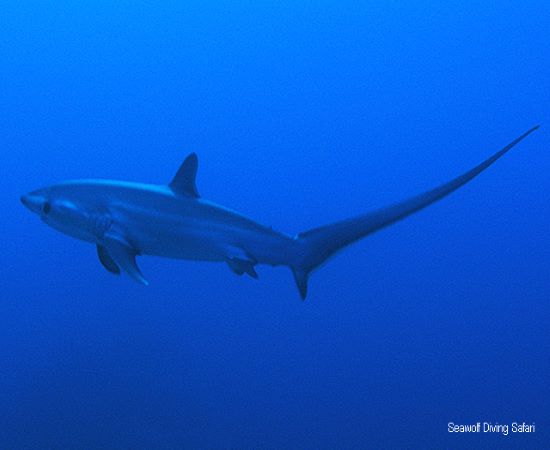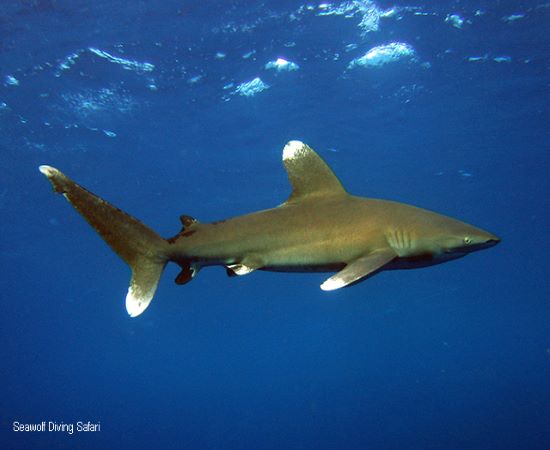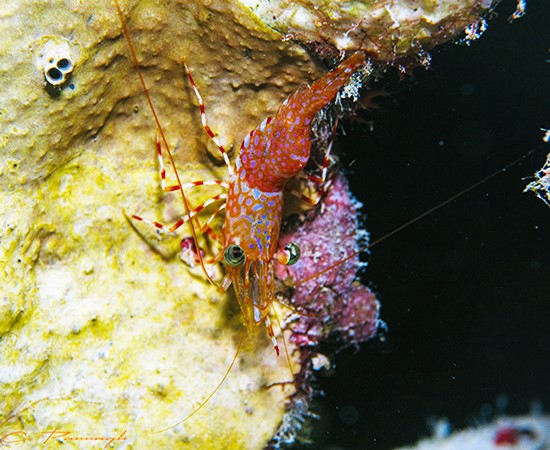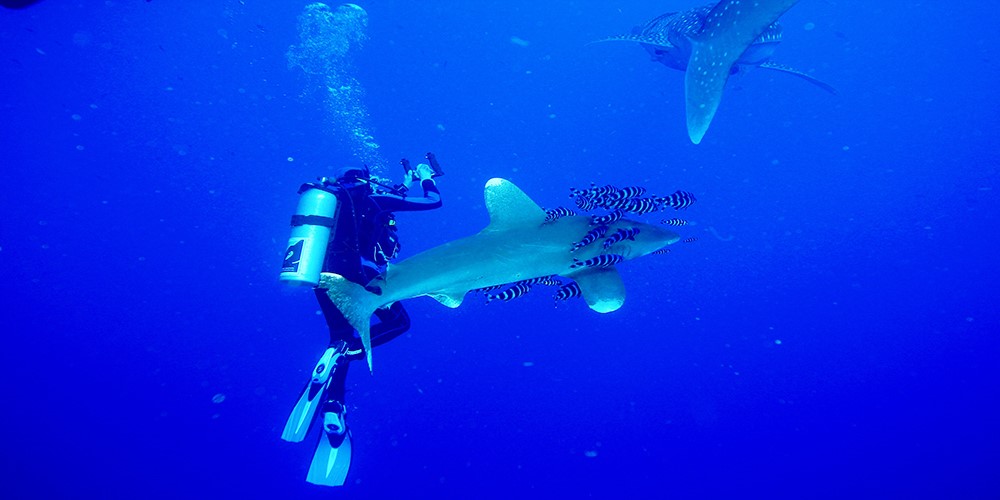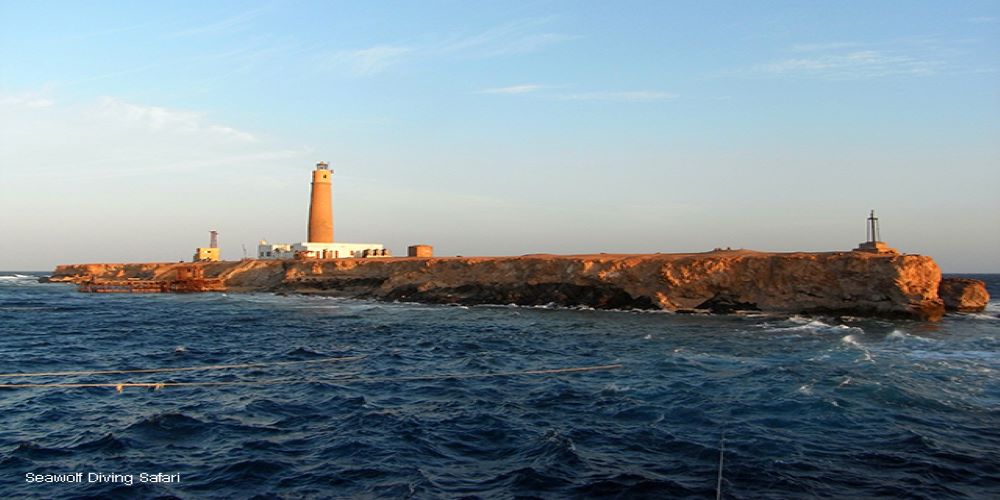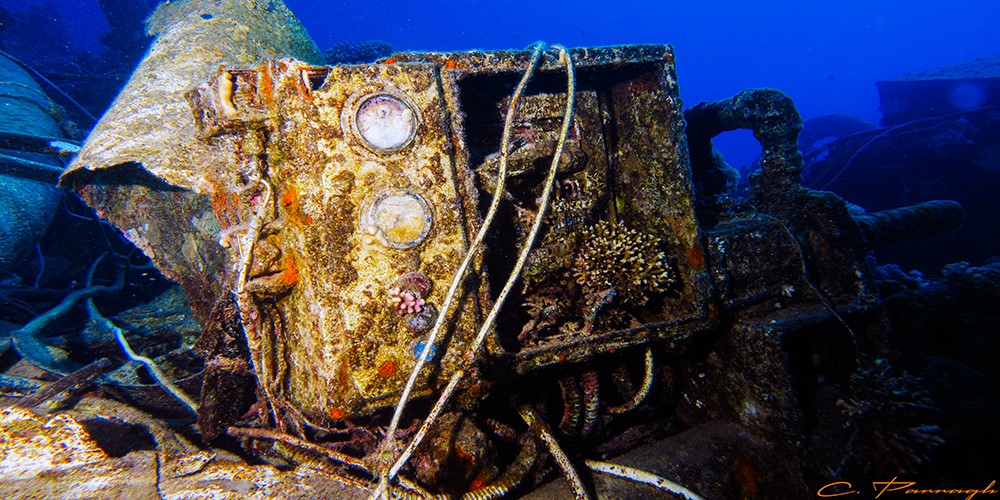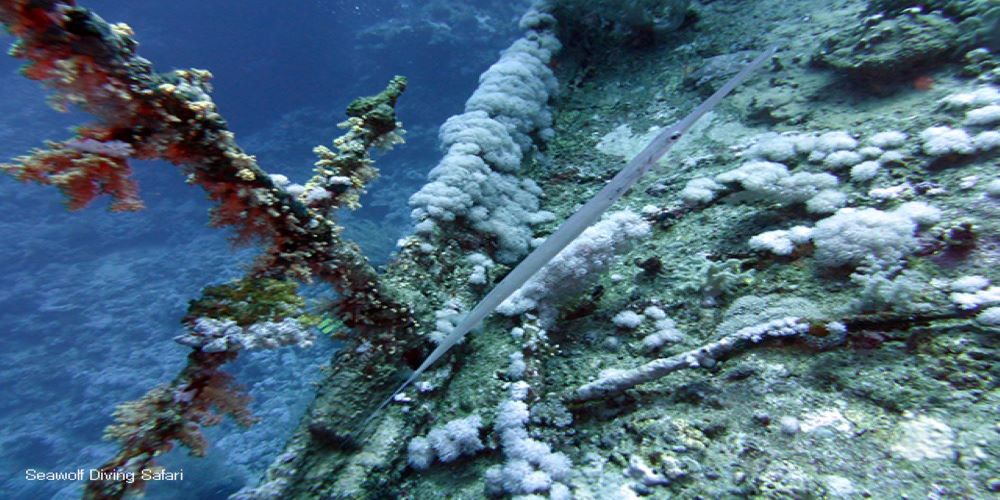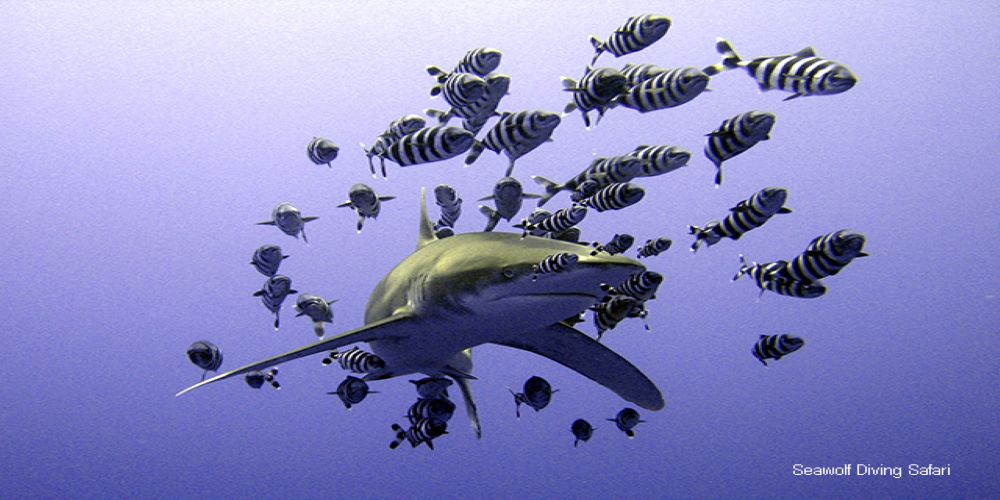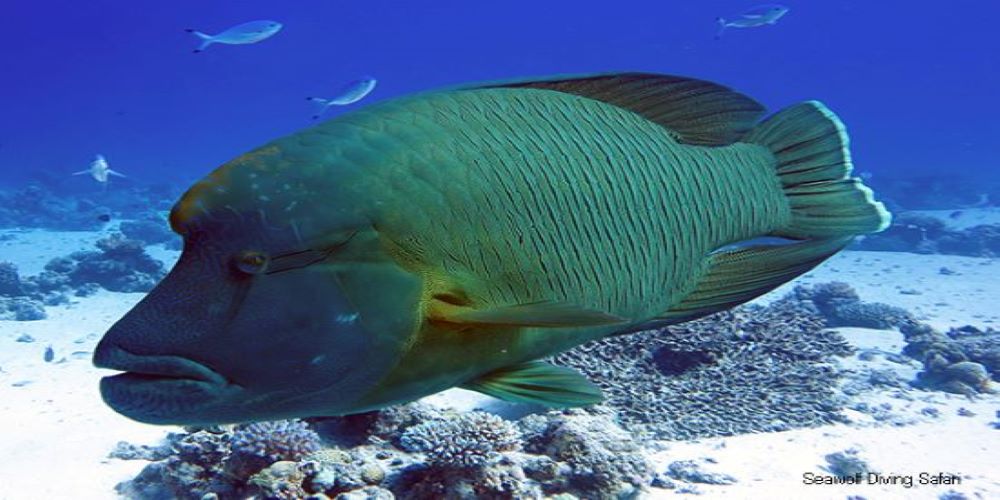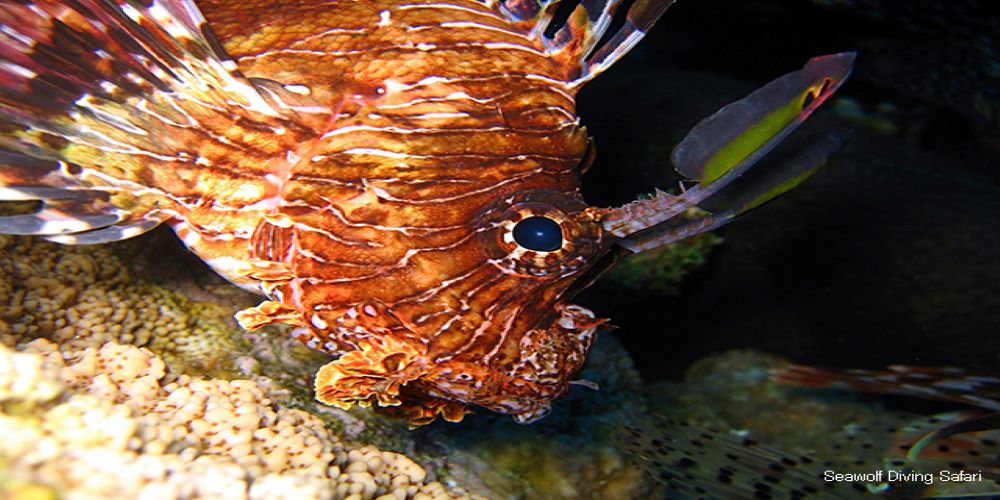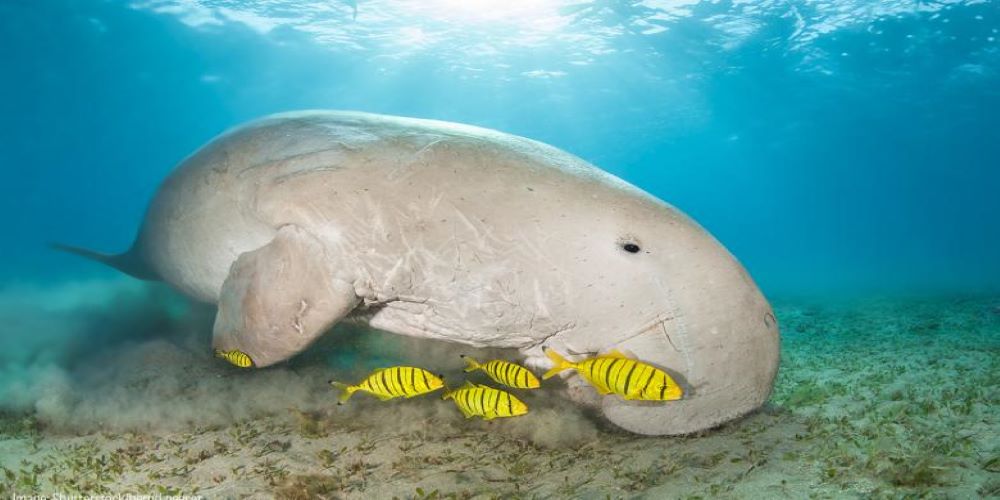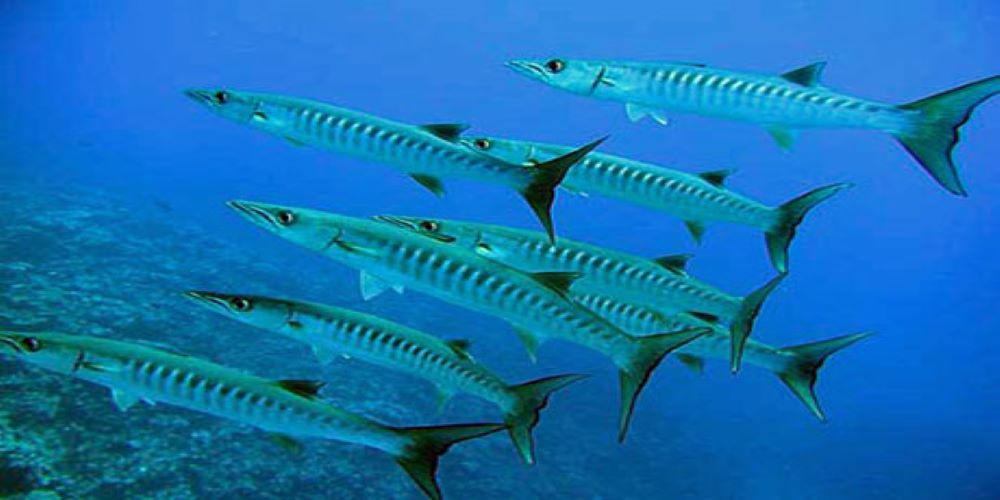Brother Islands & Elphinstone
- The "big brother" impresses with its drop offs and two wrecks - the Numidia and the Aida.
- The "little brother" is in no way inferior to it in terms of fish abundance. It impresses with its colorful hard and soft corals on many overhangs.
- Also big fish like thresher sharks, hammerhead sharks, grey sharks or oceanic white tip sharks provide exciting dives at both "brothers".
- After the Brothers we continue to Elphinstone Reef.
- Elphinstone impresses with frequent encounters with oceanic whitetip sharks, some of which also swim their courses under the boats. On the plateaus in the north you can also often find hammerhead sharks.
Expect to see
Abu Dabab
A unique structure makes this reef so remarkable: there are notches and small caves, also a stunning coral garden. All kinds of emperor and banner fish are at home here, but also reef sharks. Due to its location and its maximum depth of 16m, Abu Dabab I is excellent for relaxed day and exciting night dives.
In the south, almost exactly in the middle, there is a single block. There you will see bright red lionfish, as well as feather stars and at night basket stars. In addition, dolphins keep passing by in the south. In the southeast there is another collection of ergs with soft and hard corals, around which there are occasional hawksbill turtles and sharks.
To the north is the famous "Heaven one". Many stories are told around this wreck. Not far away you will find anemone colonies and a cave system overgrown with ancient corals, before diving into two lagoons on the west side with mighty corals and schools of barbels and snappers.
On the west side, an ancient coral formation stretches south with some boulders where reef sharks like to sleep. At the edge of the reef you can find remains of amphorae.
Elphinstone
From Marsa Alam the boat goes about one and a half hours north to Elphinstone Reef! The reef top of Elphinstone Reef lies at a depth of between one and three meters, depending on the water level. Strong surface currents and lots of boat traffic make snorkeling here impossible.
Divers, however, can dive right into a challenging treat! The reef is known for its exceptional biodiversity and, of course, sightings of large fish. In the north we dive on a sloping plateau from 18 to 40 meters and in the south on the underwater terraces. The west and east walls drop off steeply into the depths. The Elphinstone reef has a total length of about 600 meters and a width of 70 meters.
In large numbers we can see hard and soft corals in all colors. In addition, there are turtles, moray eels, loceanic white tip sharks, hammerhead sharks and pretty much everything that the Red Sea has to offer.
Big Brother Island
The Big Brother has a length of 200m and a width of 60m. It is almost perpendicular to the north-south direction and is a steep-walled reef except for the eastern plateau. On the island you usually have the opportunity to stretch your feet, smoke a shisha with the lighthouse keeper or buy small souvenirs and enjoy the view from the lighthouse. This can change depending on the mood of the military.
The wreck of the "Numidia" lies diagonally on the reef from 15m to 75m depth. The general cargo ship hit the west side in 1901 after a navigation error. Its cargo consisted of rails and railroad wheels. It is spread around the wreck. The overgrowth of the wreck stops almost abruptly at 40 meters.
The Numidia is one of the most beautifully overgrown wrecks in the world.
The "Aida", which nestles against the reef on the southern side at a depth of 30m to 65m, has been resting there since she ran aground on the fringing reef in rough seas in 1953. She was to bring personnel for the lighthouse and material for the island. Storms in early 2010 have left the wreck a bit battered.
Around the western end there is usually high wave and some current. If it is possible to dive there in the afternoon, you have the chance to see gray reef sharks and between the wrecks hammerhead sharks from time to time.
On the eastern plateau you can see thresher sharks, also gray reef sharks can be seen there very often. Further on the north side there are nice notches and the reef wall is beautifully covered with soft and hard corals. In addition there are all kinds of fish.
To the south is the jetty that supplies the lighthouse. On both sides you will find small notches in two to five meters depth with gigantic schools of fish, hunting cornetfish, juvenile napoleon wrasse. In the open water area, hunting mackerels, tunas and barracudas often pass by.
Numidia
The Red Sea has a width of 180 km at the Brothers, yet the crew managed to hit this small island - shortly after two o'clock in the morning, Captain Craig was rudely awakened by the violent impact of the ship on the reef at the northern end of the "Big Brother".
The "officer on watch", Merwood, had probably fallen asleep at the same time as his boss. The resulting course then led the ship in truly somnambulistic safety right into the middle of the reef.
The ship was thus stuck in and on the narrow fringing reef and all efforts to free itself failed.
In the following days, attempts were made to tow the Numidia free with the help of other ships, but this failed.
Captain Craig was left with the thankless task of remaining on the desolate island for several more weeks to supervise the salvage of the cargo.
Probably in the winter storms of 1901/02, the ship was then torn from the reef and it sank for good.
Aida
Originally intended for the Egyptian Port and Lighthouse Administration, she was later used for ferry and supply work in Egyptian ports.
The AIDA was to provide supplies for the Egyptian soldiers who were always stationed on the southeast coast of Big Brother Island on a bi-monthly basis. She carried fresh water, food and the next guard shift.
On September 15, 1957 in a heavy storm, the captain, ignoring several warnings, decided to go anyway and tried to moor at Big Brother. He struck the reef.
The AIDA began to sink rapidly and the captain had no choice but to abandon ship with his crew. A lifeboat was able to be lowered and all 77 sailors were still safely picked up and set down on Big Brother before the AIDA sank.
The dive on the AIDA is an extraordinary dive, no matter how much experience you have as a diver. It leaves you wondering how a ship can sink like that and stand on the sloping reef edge, as if parked. Since the ship no longer contains any cargo, one suspects that this has slipped through the wreck and now lies in deeper regions on the ground. Same as, the AIDA stands bolt upright on the sloping reef edge, the highest point at 25 m, the screw at 57 m. Apart from the collision with the reef, the ship is still completely intact.
It has been there for more than 40 years now and is becoming more and more part of the reef, overgrown with corals.
Small Brother Island
Little Brother runs from northwest to southeast at 100m long and 50m wide. To the north, Little Brother runs somewhat wedge-shaped. Its height is 11 to 12m and it is surrounded by a fringing reef that seems to literally guard it. On the southeast side, where the moorings are, the reef drops steeply down to 10m, where there is a small reef nose that turns into a slight slope. It ends with an overhang at 37m. After that, the wall drops further into the depths. There, a lagoon like wall runs from the north to the large gorgonian garden that extends from 18m to well over 40m in the east.
Small Giftun Island
On this drift dive you jump into the water in the open sea, approximately in the middle of the south coast of the smaller of the two military islands Giftun and Seghir.
The feeling of being driven by the current into the blue water is unique and even more exciting can be the encounter with huge but tame Napoleon fish. They suddenly appear as large shadows in the blue water and curiously approach the divers.
This unforgettable glide is aimed at the vertical wall of Giftun Island, which slopes down to the bottom at a depth of 90 meters, but can confidently be explored at much shallower depths.
Just as beautiful, however, is the dive made along the wall at shallower depths. This side of Giftun Island is called Gorgonian Reef, which testifies to the abundant growth of horn or sea fan corals.
The dive ends in the lagoon in the south of the island, where the moored boat is located. Here you can often meet huge moray eels, which are close to the numerous divers. The variety of stony corals, fire corals and various other hard corals make the final part of this dive extremely interesting.
Shaab - Ras Disha
The boat is parked in the southern, wind-protected area.
You can either do a drift dive with the zodiac or dive the three ergs in the shallow area from the boat.
For a "drift" you let the zodiac take you to the north and from there you dive with the current along the steep slope. It is always worth taking a look into the blue to keep an eye out for the big predators.
It is quite possible that a reef shark will pass by.
When diving from the boat, one circles the three ergs at a depth of 10 - 12 meters.
Shaab Shona
The lagoon is formed from a dried up river (wadi) and with a diameter of 150m between 5 and 45m deep. You can still see the wadi in the middle as a channel that rises to the north and south. In the north there is a plateau whose edges drop from 14 to over 40m.
The north side is characterized by boulders where you can find ghost pipefish, long-jawed makerels, glassfish and crocodile fish, but of course also as many different coral species. They reach from the reef edge partly down to 20m and are covered with life.
Abu Kafan
As an outer reef, "Abu Kafan" is of course completely exposed to the current, but this is exactly what makes it so interesting and so colorful. This is the only reason why we can see a variety of fishes and a large population of different coral species, which are topped by the big fishes in the blue water.
The reef top of "Abu Kafan" is at a depth of three meters, the actual diving area between ten and 30 meters, after that it goes steeply downhill and one can get a bit queasy or dizzy here, although we cannot actually "fall".
Bigeyes and schools of barracuda welcome us as well as gray reef sharks, whitetip sharks and hammerheads. The last three don't stop by here as often as some turtles, but that's what makes it so appealing. Soft corals, fan corals and black corals complete the picture of "Abu Kafan" perfectly.
Bigeyes and schools of barracuda welcome us as well as gray reef sharks, whitetip sharks and hammerheads. The last three don't stop by here as often as some turtles, but that's what makes it so appealing. Soft corals, fan corals and black corals complete the picture of "Abu Kafan" perfectly.
Itinerary
This tour can start in Hurghada and end in Port Ghaleb or start in Port Ghaleb and end in Hurghada.
(If the tour starts in Hurghada, there will be also possible the dive sites Small Giftun Island, Ras Disha or Abu Kafan).
ATTENTION: The tour description is only a suggestion. Which dive sites are dived on the tour depends on many factors, including wind and weather.
Arrival
After arrival in Hurghada or Marsa Alam transfer to the boat.
Check in, dinner and spending the first night onboard in the marina.
Departure
Departure in the morning.
Familiarization of the boat,
Diving, safety and equipment briefing.
Dives at Small Giftun Island
Ras Disha
Dives at Ras Disha and Abu Kafan
Brother Islands
Dives at
Big Brother Island with Numidia and Aida Wreck
Small Brother Island
Elphinstone Reef
Dives at Elphinstone
Elphinstone Reef
Dives at
Elphinstone reef
Shaab Shona
Return
Dive at Abu Dabab
Return to the port
For safety reasons you should not dive 24 hours before your flight home.
Check out
Breakfast and check out no later than 10 am.
Transfer to the airport or hotel.

 ENGLISH
ENGLISH
 РУССКИЙ
РУССКИЙ
 DEUTSCH
DEUTSCH

